Biasi Riva Plus HE Combi ERP 24kw and 28kw User manual
- Category
- Water heaters & boilers
- Type
- User manual

Wall hung, fanflue, roomsealed, high efficiency gas boiler
User manual and
Installation instructions
Riva Plus HE ERP
Models G.C. Appl. No.
RIVA PLUS HE 24C ERP 47-583-41 COMBI BOILER
RIVA PLUS HE 28C ERP 47-583-42 COMBI BOILER

- 2 -
WARNING
Congratulations on your choice.
Riva Plus HE ERP are condensing high efciency sealed chamber fan ue gas boilers. They
are fully electronically controlled and have electronic ignition.
The materials they are made of and the control systems they are equipped with give you
safety, a high level of comfort and energy savings to allow you to get the greatest benet out
of independent heating.
Riva Plus HE ERP allow a higher efciency by reducing the ue gas temperature such that
the water vapour formed during the combustion is condensed out.
This allows a gain of useful heat that otherwise would be lost.
Biasi UK Ltd is a licensed member of the Benchmark Scheme which aims to improve the
standards of installation and commissioning of domestic heating and hot water systems in
the UK and to encourage regular servicing to optimise safety, efciency and performance.
Benchmark is managed and promoted by the Heating and Hot water Industry Council. For
more information visit www.centralheating.co.uk.
DANGER: The indications marked with this symbol must be observed to pre-
vent accidents of mechanical or generic origin (e.g.: Injuries or bruises).
DANGER: The indications marked with this symbol must be observed to pre-
vent accidents of electric origin (electrocution).
DANGER: The indications marked with this symbol must be observed to pre-
vent the risk of re or explosion.
DANGER: The indications marked with this symbol must be observed to pre-
vent accidents of heat origin (burns).
ATTENTION: The indications marked with this symbol must be observed to
prevent malfunctioning and/or damage to materials of the appliance or other
objects.
ATTENTION: The indications marked with this symbol are important informa-
tion that must be carefully read.

- 3 -
WARNING
Remember that...
The manual must be read thoroughly, so that you will be able to use the boiler in a safe
and sensible way and must be carefully kept. It may be necessary for reference in the
future.
The lighting up must be carried out by a competent and responsible engineer.
The manufacturer
• disclaims all liability for any translations of the present manual from which incorrect
interpretation may occur;
• cannot be held responsible for non-observance of instructions contained in this manual
or for the consequences of any procedure not specically described.
Please ensure that the installer has fully completed the Benchmark Checklist on the inside
back pages of the installation instructions supplied with the product and that you have signed
it to say that you have received a full and clear explanation of its operation. The installer is
legally required to complete a commissioning checklist as a means of complying with the
appropriate Building Regulations (England and Wales).
All installations must be notied to Local Area Building Control either directly or through a
Competent Persons Scheme. A Building Regulations Compliance Certicate will then be
issued to the customer who should, on receipt, write the Notication Number on the Bench-
mark Checklist.
This product should be serviced regularly to optimise its safety, efciency and performance.
The service engineer should complete the relevant Service Record on the Benchmark
Checklist after each service.
The Benchmark Checklist will be required in the event of any warranty.
Using the boiler...
Before lighting the boiler you are advised to have a Registered Gas
Safe Registered Engineer check that the installation of the gas supply is
• gas-tight;
• of the correct gauge for the ow to the boiler;
• tted with all the safety and control devices required by the current Regulations.
Ensure that
• the installer has connected and terminated the pressure relief valve in a manner which
allows safe discharge. The manufacturers are not responsible for damage caused by
opening of the pressure relief valve and consequent escape of water, if this is not con-
nected and terminated;
• the installer has connected the condensate outlet to a suitable drain pipe.

- 4 -
WARNING
On detecting the smell of gas:
• do not operate any electrical switches, the telephone or any device that may produce
sparks;
• open the windows and doors at once to create a draught of air which will purge the area;
• shut off the gas cocks;
• get the assistance of a qualied person. Emergency telephone number
Tel 0800 111999.
Do not touch the appliance with parts of the body that are wet or damp and/or bare feet.
Do not block or modify the condensate outlet and pipe work.
In case of structural work or maintenance near the ue and ue terminal turn off the
appliance. On completion of the work, have a professionally qualied person check there
efciency.
Repairs (under guarantee) must be carried out only by a Biasi an approved engineer, us-
ing genuine spare parts. Thus do no more than switching off the boiler yourself (see the
instructions).
Your boiler allows heating up of water to a temperature less than boiling point therefore it
• must be connected to a central heating system and/or a hot water supply system, com-
patible with its performance and output;
• can be used only for those purposes for which it has been specially designed;
• must not be touched by children or by those unfamiliar with its operation;
• must not be exposed to weather conditions.
During the operation it is quite normal that the boiler produces a white plume of conden-
sation vapour from the ue terminal. This is due to the high efciency of the appliance and
may be particularly evident with low outdoor temperatures.
Safe handling of substances
Biasi products are manufactured in accordance with ISO 9001 and do not, and will not,
contain any hazardous materials or substances such as asbestos, mercury or C.F.C.’s. The
appliance packaging does not contain any substances, which may be considered a hazard
to health.
When handling or lifting always use safe techniques
• keep your back straight, bend your knees, don't twist;
• move your feet, avoid bending forwards and side ways and keep the load as close to your
body as possible.
Where possible transport the boiler using a sack truck or other suitable trolly.
Always grip the boiler rmly, and before lifting feel where the weight is concentrated to estab-
lish the centre of gravity, repositioning yourself as necessary.

- 5 -
WARNING
Combustion chamber panels
Material: mineral bres
Known hazards - Some people can suffer reddening and itching of the skin. Fibre entry into
the eye will cause foreign body irritation, which can cause severe irritation to people wearing
contact lenses. Irritation to respiratory tract.
Precautions - Dust goggles will protect eyes. People with a history of skin complaints may
be particularly susceptible to irritation. High dust levels are only likely to arise following harsh
abrasion. In general, normal handling and use will not present high risk. Follow good hygiene
practices; wash hands before, touching eyes, consuming food, drinking or using the toilet.
First aid - Medical attention must be sought following eye contact or prolonged reddening of
the skin.
Sharp Edges
Caution should be taken when handling the boiler to avoid sharp edges on the boiler.
Boiler installation and commissioning tips
The installation must be carried out by a qualied Gas Safe Registered Engineer who will
be responsible for observing the current Regulations and the completion of the Bench-
mark Gas Boiler System Commissioning Checklist, located at the back of this User man-
ual.
Internally installed mains water meters
Please ensure if the property has had a water meter installed inside the property, that it does
not include a non-return valve. Should you nd that it does include a non-return valve then
provision of a WRAS approved mini expansion vessel must be made.
Biasi optional WRAS approved easy t 15 mm mini shock arrestor kit BI9999 999 can
be obtained through your local Biasi stockist.

- 6 -
WARNING
Abbreviations used in the manual:
C.H. = Central heating
D.H.W. = Domestic hot water
D.C.W. = Domestic cold water
Installing the boiler...
You must ensure that you remove the transit caps and plugs from the boiler connections
which are tted to every boiler.
Keep the boiler clear of dust during installation and in particular do not allow any dust or
debris to enter the top of the boiler where the ue connection is made. It is recommended
that you put a dust sheet over the top of the boiler until you are ready to make the ue
connection.
Remember to release the auto air purge valve on the pump assembly before lling the
boiler. See the instructions to identify the location of this device.
This boiler allows you to control the ow temperature of the central heating system at
very low levels. In case of underoor heating system a temperature limiting device (e.g. a
safety thermostat) is recommended to stop the boiler in case that the water temperature
exceeds the design temperature.
You are strongly advised to ush out the system both hot and cold in order to remove any
system and installation debris to the British Standard BS 7593 code of practice.
It is also sensible to initially re and commission the boiler before connecting any external
controls such as a room thermostat. By following this procedure, if you have a subse-
quent problem this method can eliminate the external controls from your fault analysis.
Some products incorporate an anti cycling time delay. It is normal when rst switching the
boiler on for the boiler to operate on heating for a few seconds then switch off. After 3 - 4
minutes has elapsed the boiler will then re ignite and operate perfectly normally. The igni-
tion delay cycle does not prevent normal operation of the boiler to provide D.H.W.
If you are in any doubts as to the installation or operation of the boiler please read the
instruction manual thoroughly and then if necessary contact Biasi UK for advice and as-
sistance.
Guarantee conditions. The guarantee registration form must be returned within 30 days
of purchase, failure to comply will invalidate the guarantee.
Please remember that if you are in any doubt about the installation of this product you can
contact our Technical Helpline on tel. 01922 714 600.

- 7 -
TABLE OF CONTENTS
1 APPLIANCE DESCRIPTION ............ 8
1.1 Overview............................... 8
1.2 Control panel ........................... 8
1.3 Isolation valves .......................... 8
1.4 Technical data........................... 8
1.5 Operation lights ......................... 9
2 INSTRUCTIONS FOR USE . . . . . . . . . . . . 10
2.1 Warnings.............................. 10
2.2 Relling procedure ...................... 10
2.3 Ignition ................................11
2.4 C.H. circuit temperature ...................11
2.5 D.H.W. temperature ..................... 12
2.6 Switching off ........................... 13
2.7 Built in time switch A ..................... 13
2.8 Built in time switch B..................... 15
2.9 Built in time switch C..................... 17
2.10 Built in time switch D..................... 19
3 USEFUL ADVICE.................... 22
3.1 Central Heating......................... 22
3.2 Frost protection......................... 22
3.3 Condensate drain ....................... 22
3.4 Periodic maintenance .................... 22
3.5 External cleaning ....................... 22
3.6 Operational faults ....................... 23
4 TECHNICAL INFORMATION........... 25
4.1 Overview.............................. 25
4.2 Main diagram .......................... 26
4.3 Technical data mod. Riva Plus HE 24C ERP . . 28
4.4 Technical data mod. Riva Plus HE 28C ERP . . 32
4.5 Hydraulic specications .................. 36
4.6 Expansion vessel ....................... 36
5 GENERAL REQUIREMENTS .......... 37
5.1 Related documents...................... 37
5.2 Location of appliance .................... 37
5.3 Flue system ........................... 38
5.4 Gas supply ............................ 39
5.5 Air supply ............................. 40
5.6 Ventilation ............................. 40
5.7 Condensate drain ....................... 40
5.8 Water circulation (C.H.) .................. 41
5.9 Domestic water......................... 42
5.10 Water treatment ........................ 42
5.11 Electrical supply ........................ 43
6 INSTALLATION ..................... 44
6.1 Warnings.............................. 44
6.2 Precautions for installation ................ 44
6.3 Installing the bracket..................... 45
6.4 Overall dimensions ...................... 45
6.5 Joints ................................ 45
6.6 Mounting the boiler ...................... 46
6.7 Fitting the ue system.................... 46
6.8 Choice of ue .......................... 46
6.9 Electrical connections.................... 49
6.10 External frost protection .................. 51
7 COMMISSIONING . . . . . . . . . . . . . . . . . . . 52
7.1 Warnings.............................. 52
7.2 Electrical installation ..................... 52
7.3 Gas supply installation ................... 52
7.4 Filling the D.H.W. system . . . . . . . . . . . . . . . . . 52
7.5 Initial lling of the system ................. 52
7.6 Condensate pipe and traps ............... 54
7.7 Lighting the boiler ....................... 54
7.8 Checking the gas pressure at the burner ..... 55
7.9 Checking the burner ignition............... 56
7.10 Checking the ignition device ............... 56
7.11 Checking the ue system ................. 56
7.12 Check pump operation/pump release........ 57
7.13 Checking the condensate drain pipe ........ 57
7.14 Instructing the user ...................... 57
8 GAS CONVERSION ................. 58
8.1 Warnings.............................. 58
8.2 Procedures ............................ 58
9 MAINTENANCE..................... 60
9.1 Warnings.............................. 60
9.2 Dismantling the external panels ............ 60
9.3 Emptying the D.H.W. system .............. 60
9.4 Emptying the C.H. system ................ 60
9.5 Combustion analysis check ............... 61
9.6 Cleaning the primary heat exchanger........ 61
9.7 Checking the pressurisation in the expansion
vessel . . . . . . . . . . . . . . . . . . . . . . . . . . . . . . . . 61
9.8 Cleaning the burner ..................... 61
9.9 Checking the ue system ................. 61
9.10 Drain pipe inspection .................... 61
9.11 Visual inspection of appliance ............. 61
9.12 Gas pressures and tightness .............. 61
9.13 Water inhibitor concentration .............. 61
10 BENCHMARK COMMISSIONING AND
SERVICING SECTION................ 63
Gas boiler system commissioning checklist ... 64
Service record.......................... 65
Appliance category: II2H3+ (Gas G20 20 mbar, G30 29 mbar, G31 37 mbar)
Country of destination: United Kingdom (GB) Ireland (IE)
This appliance conforms with the following EEC directive:
Gas Directive Gas 2009/142/EC
Efciency Directive 92/42/EEC
Electromagnetic Compatibility Directive 2014/30/EU
Low Voltage Directive 2014/35/EU
Ecodesign Requirements Directive 2009/125/EC
The manufacturer, in the continuous process to improve his products, reserves the right to modify the data expressed
in the present documentation at any time and without prior notice.
The present documentation is an informative support and it can not be considered as a contract to-wards third parties.

- 8 -
USE
APPLIANCE DESCRIPTION
1 APPLIANCE DESCRIPTION
1.1 Overview
The model and serial number of the boiler
are printed on bottom right side.
Fig. 1.1
1
2
3
1 Case front panel
2 Control panel
3 Control panel cover
1.2 Control panel
4 C.H. circuit temperature and pressure
gauge
5 Time switch (C.H. control)
6 Lock-out signal lamp
7 Lockout reset button
8 Function selector and C.H. temp. con-
trol knob
9 D.H.W. temperature control knob
10 Appliance operation lights
1.3 Isolation valves
Provide for the installation
of a stop valve on the D.C.W.
inlet pipe.
Fig. 1.2
16
15
14
13
12
11
11 Condensate drain pipe
12 C.H. return valve
13 D.C.W. inlet valve
14 Gas inlet valve
15 D.H.W. outlet pipe
16 C.H. ow valve
1.4 Technical data
For detailed technical data see sections
"Technical Data" on pag. 28 or pag. 32.
10 9 8 7 6 5 4
Fig. 1.3

- 9 -
USE
APPLIANCE DESCRIPTION
1.5 Operation lights
Three lights (10 in Fig. 1.3) give detailed
indication regarding the operation of the
boiler.
The following table gives the relationship
between each of the possible light combina-
tions and their meaning.
A short pulse every
4 seconds: stand-by
condition
position.
Anti-freeze system ac-
tive
1 second pulse every
2 seconds: normally
operating boiler. Func-
tion selector in
or
position
C.H. operation
D.H.W. operation
Frost protect operation
D.H.W. operation
Excessive temperature
on primary circuit
If the lights combination observed is not
included in the above table a fault may be
indicated.
Reference should be made to the following
table.
In this case switch off the boiler, as de-
scribed in section "Switching off" to page 13
and call a competent and responsible Ser-
vice Engineer.
Faulty C.H. tempera-
ture probe NTC
Faulty D.H.W. tempera-
ture probe NTC
Faulty ue temperature
probe NTC
Faulty primary circuit
(no water or low C.H.
pressure)
Faulty primary circuit
(absence of ow)
Faulty air pressure
sensor
Lack of burner ignition
(no ignition signal from
the full sequence igni-
tion device)
Safety thermostat lock
out
Flue temperature probe
NTC lock out
Flame detection error
Other faults
Lack of power supply
or fauly electr. control
p.c.b.
Meaning of symbols:
Lamp OFF
Lamp ON
Flashing lamp, alone or simulta-
neously with an other lamp
Flashing lamp, alternate with an-
other lamp

- 10 -
USE
INSTRUCTIONS FOR USE
2 INSTRUCTIONS FOR USE
2.1 Warnings
Biasi UK Ltd support the Benchmark initia-
tive. The Benchmark Checklist is located
at the back of this manual and should be
completed by
the Installing/Commission-
ing Engineer and handed over to the User
for future reference by other visiting Engi-
neers. Also included is the Service Interval
Record card that should be completed by
the Service Engineer following the annual
service maintenance of the boiler and sys
-
tem.
All Gas Safe Registered Installers carry a
Gas Safe ID card, and have a registration
number
. Both should be recorded in your
Benchmark Checklist. You can check your
Installer is registered by calling Gas Safe
direct on 0800 408 5500, or go on line at
www.GasSafeRegister.co.uk.
In order to guarantee safety and correct op
-
eration, it is essential that all the tests are
carried out
by a competent and responsible
service engineer before lighting up the boiler.
The tests are described in the installation in
-
structions in section 7 commissioning.
Ensure that
the C.H. circuit is regularly lled
with water (even if the boiler is only used for
D.H.W. supply) checking that the pressure in
-
dicated on pressure gauge 4
is not lower than
that shown in Fig. 2.2.
If the pressure reading on the pressure gauge
is below that shown in Fig. 2.2, then the sys
-
tem will require topping up. A lling loop is
normally provided
by the Installer for this pur-
pose.
If you
are in any doubt regarding this pro-
cedure you are advised to contact your In-
staller or an Approved Engineer.
This
appliance
is provided with a built in anti-
freeze system that operates the boiler when
the temperature is below 5 °C.
Therefore, when the boiler is not lit or used
in cold weather, with consequent risk of freez
-
ing do not switch off the boiler at the fused
spur isolation
switch or close the gas inlet
cock.
When you do not expect to use the boiler for
a long period and the boiler is not to be used
for frost protection then follow the instructions
given in section "Switching off" to page 13.
2.2 Relling procedure
• Isolate the boiler from the electrical supply
at the fused spur. Reconnect the lling loop
as demonstrated in Fig. 2.1.
Fig. 2.1
Control
valve
Double
check valve
Temporary
connection
Supply pipe
(cold water
inlet)
Control valve
C.H. return pipe
• Open the valves of the lling loop and watch
the gauge until it reaches normal lling pres-
sure as shown in Fig. 2.2.
Fig. 2.2
Normal
lling
pressure
4
• Close the valves and remove the lling loop.
If you experience any difculty with the op-
eration of the boiler, switch off the boiler
immediately at the fused spur isolation
switch
and
contact your Installer or an ap-

- 11 -
USE
INSTRUCTIONS FOR USE
proved Service Engineer.
Air introduced into the boiler during this lling
process will vent through the automatic air
purger tted to the boiler. You may also nd
it necessary to vent air from your radiator cir
-
cuit using your radiator key, however be aware
that excessive
venting will cause the pressure
in the system to drop.
Always ensure that the pressure gauge is set
at the required pressure.
2.3 Ignition
• Check that the valves located in the lower
part of the boiler are open Fig. 2.3.
Fig. 2.3
Open position
• Turn on the electricity supply to the boiler
switching on the fused spur isolation switch.
The appliance operation light 10 (Fig. 2.4)
will ash every 4 seconds (stand-by condi
-
tion).
•
If the boiler is to be used for C.H. and
D.H.W., position the function selector 8 as
in Fig. 2.4. The appliance operation light 10
will ash every 2 seconds (operating boiler).
Fig. 2.4
10
8
• If D.H.W. supply only is required, position
the function selector 8 as in Fig. 2.5. The
appliance operation light 10 will ash every
2 seconds (operating boiler).
Fig. 2.5
10
8
2.4 C.H. circuit temperature
The output temperature of C.H. water is ad-
justable from a minimum of about 40°C to a
maximum of
about 85°C (Fig. 2.6), by turning
the function selector (8).
Adjustment of C.H. output on the boiler is au
-
tomatic.
The greatest
output pre-set in the factory can,
however, be reduced in level according to ac-
tual system requirements; this does not affect
the maximum output in
D.H.W
. operation.
Such adjustments must be carried out by a
qualied person; therefore we advise you to
contact your installer or Service Agent.
Adjustment of the boiler temperature alters
the gas ow at the burner according to the
thermal demand in the system. So it is usual
to see the burner lit at the minimum level for
more or less long periods.
Fig. 2.6
Minimum
Maximum

- 12 -
USE
INSTRUCTIONS FOR USE
Adjustment
In order to achieve optimal settings for econo-
my and comfort, we recommend adjusting the
operating temperature
of the C.H. water ac-
cording to the outside temperature, position-
ing the knob as follows:
Fig. 2.7
From 5 to 15 °C
Between
- 5 and +5 °C
Lower
than - 5 °C
Your qualied installer will be able to recom-
mend the most suitable adjustment for your
system.
The temperature
and pressure gauge (4, Fig.
1.3 on page 8) will allow you to check that the
set temperature is obtained.
2.5 D.H.W. temperature
The temperature of the D.H.W. leaving the
boiler can be varied from a minimum of about
35°C to a maximum of about 55°C (Fig. 2.8),
by turning the temperature control knob 9.
Fig. 2.8
Minimum
Maximum
Adjustment of the D.H.W. temperature is com-
pletely separate from that of the C.H. circuit.
The adjustment
system integrated within the
boiler automatically controls the ow of gas to
the burner in order to keep the temperature of
D.H.W. delivered constant, between the limits
of maximum and minimum output.
Where the demand is at a low level or with the
temperature set to the minimum, it is normal to
see a cycle of lighting and extinguishing of the
burner when running.
Adjustment
It is advisable to adjust the D.H.W. tempera
-
ture to a level commensurate with the de-
mand, minimising the need to mix with cold
water.
In this way, the automatic control facili-
ties will be fully exploited.
Moreover,
where the amount of limescale pre-
sent in the water may be particularly great,
not exceeding
the position in Fig. 2.9 of the
D.H.W. temperature control knob 9 corre-
sponding to about 50°C (Fig. 2.9),minimises
annoying
incidences
of scale deposits and
clogging.
Fig. 2.9
In these cases, however, it is advisable to
install a small water treatment device or sof-
tener. With such a device you should avoid
periodic descaling.
Consequently,
the D.H.W. heat exchanger will
keep its performance consistent for a longer
period of time with resulting gas savings.
If the demand for D.H.W. is so great as to
prevent reaching a high enough temperature,
have the appropriate output limiting valve in
-
stalled by your installer or an Authorised Ser-
vice Engineer.

- 13 -
USE
INSTRUCTIONS FOR USE
2.6 Switching off
To turn the boiler off set the function selector 8
to the position shown in Fig. 2.10.
The appliance operation light 10 will ash eve-
ry 4 seconds.
Fig. 2.10
10
8
When you do not expect to use the boiler for
a long period:
• Switch off the electricity supply to the boiler,
by means of the fused spur isolation switch.
• Shut off the gas supply cock 14 and the
valves for the water circuits tted under the
boiler (Fig. 2.11).
• Empty the water circuits, if necessary, as
shown in section General access and emp
-
tying hydraulic circuits in the service manual.
Fig. 2.11
14
Closed position
2.7 Built in time switch A
The boilers are equipped with a built in elec-
tronic time switch (5, Fig. 1.3
on page 8) which
controls the C.H. operation.
Fig. 2.12
G
F E D C B
A
H
Display and control panel:
A Mode selector switch
B Reset button
C Enter button
D Increase “+” setting button
E Decrease “-” setting button
F On-off button
G Time display
H ON-OFF display
Setting the current time
Note: with a new unit or when the reset button
B has been pressed and the selector switch
A is to the
position, the time display G is
ashing.
Set the mode selector switch A to the
posi-
tion and press the buttons D or
E until the cur-
rent time appears in the display G.
The clock
starts by moving the switch A to the
AUTO position.
Setting example shown in Fig. 2.13:
Current time 16.30.
Fig. 2.13
A
Setting the switching time
20 memory locations are available, corre-
sponding to 10 on-off sequences.

- 14 -
USE
INSTRUCTIONS FOR USE
Set the mode selector switch A to the C1 posi-
tion.
The symbols
shown in Fig. 2.14 appears in
the display.
Fig. 2.14
A
Press the buttons D or E to set the desired
ON time. Press the “enter” button C to conrm
the setting and to continue programming the
OFF time.
Set the OFF time as explained above for the
ON setting and conrm by pressing the “enter”
button C. Proceed in the same way for other
settings.
Setting example shown in Fig. 2.15:
I ON time 7.45.
J OFF time 10.30.
Fig. 2.15
I J
Activating the timed settings
Set the mode selector switch A to the AUTO
position shown in Fig. 2.16.
The current time appears in the display. The
ON-OFF display H indicates the current state
of operation (according to the settings).
Fig. 2.16
A
Note: when the mode selector switch A is in
the AUTO position and the boiler is switched
off at the fused spur isolation switch, the dis-
play H
indicates only the OFF state. The other
indications are blanked.
Reading the timed settings
Set
the mode selector switch A to the C1 posi
-
tion. The symbols shown in Fig. 2.14
appears
in the display.
Press the “enter” button C. Each time the but-
ton is pressed the display shows the details of
the next setting.
Changing or deleting the timed settings
Set
the
mode selector switch A to the C1 posi
-
tion. The symbols shown in Fig. 2.14
appears
in the display.
Press the “enter” button C until the display
shows the setting to be modied or deleted.
The time setting can be modied now by
pressing button D or E and the operation can
be switched on or off by pressing the button F.
To delete a time set press the button D or E
until the symbols shown in Fig. 2.14 appears
in the time display G.
The new settings are memorized by moving
the switch A to a different position.
Manual operation
The operation of the time switch can be forced
on or off constantly or for a timed period.
To force constantly on or off the timer opera
-
tion set the mode selector switch A to
the TIM-
ER position. The symbols shown in Fig. 2.17
appears on the display.
Fig. 2.17
The operation can be switched permanently
on or off by pressing the button F and leaving
the switch A in the TIMER position. To force a
timed delay on or off operation, set the mode
selector switch A in the TIMER position.
Set the time delay by pressing the button D or
E and the operation can be forced on or off by
pressing the button F.
The time delay can be set within the following
ranges:

- 15 -
USE
INSTRUCTIONS FOR USE
1 to 23 hours with steps of 1 hour
1 to 27 days with steps of 1 day.
The time delay setting is activated by moving
the switch A to the AUTO position.
The ON-OFF display H ashes indicating that
the current state of operation has been forced.
To delete the timed delay setting, set the mode
selector switch A in the TIMER position, press
the button D or E until the symbols shown in
Fig. 2.17 appears in the display and then set
the mode selector switch A to the AUTO posi
-
tion.
Setting example shown in Fig. 2.18:
forced ON state for 4 hours.
Fig. 2.18
Resetting
To completely reset the timer, press the reset
button with a pointed object (pencil).
CAUTION: pushing the reset button will com
-
pletely erase the settings as well as all the
data, including the current time.
2.8 Built in time switch B
The combiboilers are equipped with a built in
electronic time switch which controls the C.H.
operation.
Fig. 2.19
G
F E D C B
A
H
Display and control panel
A Mode selector switch
B Reset button
C OK button
D Increase “+” setting button
E Decrease "-” setting button
F On-off button
G Time display
H ON-OFF display
Setting the current time
Press repeatedly the button A until the display
shows the symbol
.
Press the buttons D or E until the current time
appears in the display G.
The clock starts by pressing the button A to
show the symbol AUTO.
Setting example shown in Fig. 2.20:
Current time 16.30, day Thursday.
Fig. 2.20
A
Setting the switching time
28 memory locations are available, corre-
sponding to 14 on-off sequences.
Press repeatedly
the button A until the display
shows the symbol C1.
The symbols shown in Fig. 2.21 appears in
the display.
Fig. 2.21
A
Press the buttons D or E to set the desired
ON time. Press the “OK” button C to conrm
the setting and to continue programming the
OFF time.
Set the OFF time as explained above for the
ON setting and conrm by pressing the “OK”
button C. Proceed in the same way for other
settings.

- 16 -
USE
INSTRUCTIONS FOR USE
Setting example shown in Fig. 2.22:
K ON time 7.45.
L OFF time 10.30.
Fig. 2.22
K L
Activating the timed settings
The current time appears in the display. The
ON-OFF display H indicates the current state
of operation (according to the settings).
Fig. 2.23
A
Note: when the display shows the symbol
AUTO and the boiler is switched off at the
fused spur isolation switch, the display H in-
dicates only the OFF state. The other indica-
tions are blanked.
Reading the timed settings
Press
repeatedly
the button A until the display
shows the symbol C1 (Fig. 2.21).
The symbols shown in Fig. 2.21 appears in
the display.
Press the “OK” button C. Each time the button
is pressed the display shows the details of the
next setting.
Changing or deleting the timed settings
Press repeatedly the button A until the display
shows the symbol C1 (Fig. 2.21).
The symbols shown in Fig. 2.21 appears in
the display.
Press the “OK” button C until the display
shows the setting to be modied or deleted.
The time setting can be modied now by
pressing button D or E and the operation can
be switched on or off by pressing the button F.
To delete a time set press the button D or E
until the symbols shown in Fig. 2.21 appears
in the time display G.
The new settings are memorised by pressing
the button A.
Manual operation
The operation of the time switch can be forced
on or off constantly or for a timed period.
To force constantly on or off the timer opera
-
tion press repeatedly the button A until the dis-
play shows the symbol TIMER.
The symbols
shown in Fig. 2.24 appears on the display.
Fig. 2.24
A
The operation can be switched permanently
on or off by pressing the button F and leaving
the display shows the symbol TIMER.
To force a timed delay on or off operation,
press repeatedly the button A until the display
shows the symbol TIMER.
Set the time delay by pressing the button D or
E and the operation can be forced on or off by
pressing the button F.
The time delay can be set within the following
ranges:
1 to 23 hours with steps of 1 hour
1 to 27 days with steps of 1 day.
Press the button A until the display shows the
symbol AUTO.
The ON-OFF display H ashes indicating that
the current state of operation has been forced.
To delete the timed delay setting, press re
-
peatedly the button A until
the display shows
the symbol TIMER, press the button D or E
until the symbols shown in Fig. 2.25 appears
in the display and then press the button A until
the display shows the symbol AUTO.
Setting example shown in Fig. 2.25:
forced ON state for 4 hours.

- 17 -
USE
INSTRUCTIONS FOR USE
Fig. 2.25
A
Note: If during manual operation, power sup-
ply turns off, timer must be set again following
previous steps.
Resetting
To
completely reset the timer, press the reset
button with a pointed object (pencil).
CAUTION: pushing the reset button will com
-
pletely erase the settings as well as all the
data, including the current time.
2.9 Built in time switch C
The combi boilers are equipped with a built in
electronic time switch (5, Fig. 1.3 on page 8)
which controls the C.H. operation.
Fig. 2.26
I
H
G
F E D C B
A
J
Display and control panel:
A Mode selector switch
B Reset button
C Enter button
D Increase “+” setting button
E Decrease “-” setting button
F On-off button
G Day selection buttons
H Day display
I Time display
J ON-OFF display
Setting the current time and weekday
Note: with a new unit or when the reset button
B has been pressed, the rst day indicator H
on the left and the time display I is ashing.
Set the mode selector switch A to the
posi-
tion and press the buttons D or
E until the cur-
rent time appears in the display I.
Press the
day selection button correspond-
ing to the current day, considering that button
1=Monday, button 2=T
uesday and so on.
The clock starts by moving the switch A to the
AUTO position.
Setting example shown in Fig. 2.27:
Current time 16.30, day Thursday.
Fig. 2.27
A
Setting the switching time and day (or
days)
20 memory locations are available, corre-
sponding to 10 on-off sequences.
Set
the
mode selector switch A to the C1 posi-
tion.
The symbols
shown in Fig. 2.28 appears in
the display.
Fig. 2.28
A
Press the buttons D or E to set the desired
ON time.
Press the buttons G to set the desired day or
days of operation.

- 18 -
USE
INSTRUCTIONS FOR USE
Press the “enter” button C to conrm the set-
ting and to continue programming the OFF
time.
Set the
OFF time as explained above for the
ON setting and conrm by pressing the “enter”
button C. Proceed in the same way for other
settings.
Setting example shown in Fig. 2.29:
K ON time 7.45, day Monday to Friday.
L OFF time 10.30, day Monday to Friday.
Fig. 2.29
K L
Activating the timed settings
Set the mode selector switch A to the AUTO
position shown in Fig. 2.16.
The current time and day appears in the dis
-
play. The ON-OFF display J indicates the cur-
rent state of operation (according to the set-
tings).
Fig. 2.30
A
Note: when the mode selector switch A is in
the AUTO position and the boiler is switched
off at the fused spur isolation switch, the dis-
play J indicates only the OFF state. The other
indications are blanked.
Reading the timed settings
Set
the
mode selector switch A to the C1 posi
-
tion. The symbols shown in Fig. 2.28 appears
in the display.
Press
the “enter” button C. Each time the but-
ton is pressed the display shows the details of
the next setting.
Changing or deleting the timed settings
Set
the
mode selector switch A to the C1 posi
-
tion. The symbols shown in Fig. 2.28 appears
in the display.
Press
the “enter” button C until the display
shows the setting to be modied or deleted.
The day display H gives a ashing indication
of the active day or group of days.
Press the button (or the buttons) G corre
-
sponding to the day (or days) for which it is
intended
to
apply the modication. The cor-
responding day display stops ashing and a
new switching time can be set or deleted.
The time
setting can be modied now by
pressing button D or E and the operation can
be switched on or off by pressing the button F.
To delete a time set press the button D or E
until the symbols shown in Fig. 2.28 appears
in the time display I.
The new settings are memorized by moving
the switch A to a different position.
Manual operation
The operation of the time switch can be forced
on or off constantly or for a timed period.
To force constantly on or off the timer opera
-
tion set the mode selector switch A to
the TIM-
ER position. The symbols shown in Fig. 2.31
appears on the display.
Fig. 2.31
The operation can be switched permanently
on or off by pressing the button F and leaving
the switch A in the TIMER position. To force a
timed delay on or off operation, set the mode
selector switch A in the TIMER position.
Set the time delay by pressing the button D or
E and the operation can be forced on or off by
pressing the button F.

- 19 -
USE
INSTRUCTIONS FOR USE
The time delay can be set within the following
ranges:
1 to 23 hours with steps of 1 hour
1 to 27 days with steps of 1 day
The time delay setting is activated by moving
the switch A to the AUTO position.
The ON-OFF display J ashes indicating that
the current state of operation has been forced.
To delete the timed delay setting, set the mode
selector switch A in the TIMER position, press
the button D or E until the symbols shown in
Fig. 2.31 appears in the display and then set
the mode selector switch A to the AUTO posi
-
tion.
Setting example shown Fig. 2.32:
forced ON state for 4 hours.
Fig. 2.32
Resetting
To completely reset the timer, press the reset
button with a pointed object (pencil).
CAUTION: pushing the reset button will com
-
pletely erase the settings as well as all the
data, including the current time and day.
2.10 Built in time switch D
The combi boilers are equipped with a built in
electronic time switch (5 on pag. 8) which
controls the C.H. operation.
Fig. 2.33
I
F E D C B
A
J
H
G
Display and control panel
A Mode selector switch
B Reset button
C OK button
D Increase “+” setting button
E Decrease "-” setting button
F On-off button
G Day selection buttons
H Day display
I Time display
J ON-OFF display
Setting the current time and weekday
Note: with a new unit or when the reset button
B has been pressed, the rst day indicator H
on the left and the time display I are ashing.
Press repeatedly the button A until the display
shows the symbol
.
Press the buttons D or E until the current time
appears in the display I.
Press the day selection button G correspond
-
ing to the current day, considering that button
1=Monday, button 2=T
uesday and so on.
The clock starts by pressing the button A to
show the symbol AUTO.
Setting example shown in Fig. 2.34:
Current time 16.30, day Thursday.

- 20 -
USE
INSTRUCTIONS FOR USE
Fig. 2.34
A
Setting the switching time and day (or
days)
28 memory locations are available, corre-
sponding to 14 on-off sequences.
Press
repeatedly
the button A until the display
shows the symbol C1.
The symbols shown in Fig. 2.35 appears in
the display.
Fig. 2.35
A
Press the buttons D or E to set the desired
ON time.
Press the buttons G to set the desired day or
days of operation.
Press the “OK” button C to conrm the setting
and to continue programming the OFF time.
Set the OFF time as explained above for the
ON setting and conrm by pressing the “OK”
button C. Proceed in the same way for other
settings.
Setting example shown in Fig. 2.36:
M ON time 7.45, day Monday to Friday.
N OFF time 10.30, day Monday to Friday.
Fig. 2.36
M N
Activating the timed settings
The current time and day appears in the dis-
play. The ON-OFF display J indicates the cur-
rent state of operation (according to the set-
tings).
Fig. 2.37
A
Note: when the display shows the symbol
AUTO and the boiler is switched off at the
fused spur isolation switch, the display J in-
dicates only the OFF state. The other indica-
tions are blanked.
Reading the timed settings
Press
repeatedly
the button A until the display
shows the symbol C1 (Fig. 2.35).
The symbols shown in Fig. 2.35 appears in
the display.
Press the “OK” button C. Each time the button
is pressed the display shows the details of the
next setting.
The day display H gives a ashing indication
of the active day or group of days.
Changing or deleting the timed settings
Press repeatedly the button A until the display
shows the symbol C1 Fig. 2.35).
The symbols shown in Fig. 2.35 appears in
the display.
Press the “OK” button C until the display
shows the setting to be modied or deleted.
The day display H gives a ashing indication
of the active day or group of days.
Press the button (or the buttons) G corre
-
sponding to the day (or days) for which it is
intended to
apply the modication. The cor-
responding day display stops ashing and a
new switching time can be set or deleted.
The time
setting can be modied now by
pressing button D or E and the operation can
be switched on or off by pressing the button F.
To delete a time set press the button D or E
until the symbols shown in Fig. 2.35 appears
in the time display I.
Page is loading ...
Page is loading ...
Page is loading ...
Page is loading ...
Page is loading ...
Page is loading ...
Page is loading ...
Page is loading ...
Page is loading ...
Page is loading ...
Page is loading ...
Page is loading ...
Page is loading ...
Page is loading ...
Page is loading ...
Page is loading ...
Page is loading ...
Page is loading ...
Page is loading ...
Page is loading ...
Page is loading ...
Page is loading ...
Page is loading ...
Page is loading ...
Page is loading ...
Page is loading ...
Page is loading ...
Page is loading ...
Page is loading ...
Page is loading ...
Page is loading ...
Page is loading ...
Page is loading ...
Page is loading ...
Page is loading ...
Page is loading ...
Page is loading ...
Page is loading ...
Page is loading ...
Page is loading ...
Page is loading ...
Page is loading ...
Page is loading ...
Page is loading ...
Page is loading ...
Page is loading ...
Page is loading ...
Page is loading ...
-
 1
1
-
 2
2
-
 3
3
-
 4
4
-
 5
5
-
 6
6
-
 7
7
-
 8
8
-
 9
9
-
 10
10
-
 11
11
-
 12
12
-
 13
13
-
 14
14
-
 15
15
-
 16
16
-
 17
17
-
 18
18
-
 19
19
-
 20
20
-
 21
21
-
 22
22
-
 23
23
-
 24
24
-
 25
25
-
 26
26
-
 27
27
-
 28
28
-
 29
29
-
 30
30
-
 31
31
-
 32
32
-
 33
33
-
 34
34
-
 35
35
-
 36
36
-
 37
37
-
 38
38
-
 39
39
-
 40
40
-
 41
41
-
 42
42
-
 43
43
-
 44
44
-
 45
45
-
 46
46
-
 47
47
-
 48
48
-
 49
49
-
 50
50
-
 51
51
-
 52
52
-
 53
53
-
 54
54
-
 55
55
-
 56
56
-
 57
57
-
 58
58
-
 59
59
-
 60
60
-
 61
61
-
 62
62
-
 63
63
-
 64
64
-
 65
65
-
 66
66
-
 67
67
-
 68
68
Biasi Riva Plus HE Combi ERP 24kw and 28kw User manual
- Category
- Water heaters & boilers
- Type
- User manual
Ask a question and I''ll find the answer in the document
Finding information in a document is now easier with AI
Related papers
-
Biasi Advance Plus 25C, 30C, 35C User manual
-
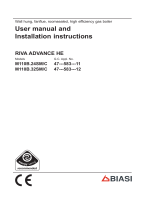 Biasi Riva Advance M110B.24SM/C, M110B.32SM/C User manual
Biasi Riva Advance M110B.24SM/C, M110B.32SM/C User manual
-
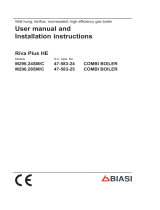 Biasi Riva Plus HE M296.24SM/C, M296.28SM/C User manual
Biasi Riva Plus HE M296.24SM/C, M296.28SM/C User manual
-
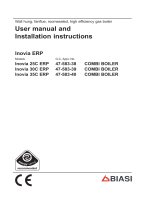 Biasi Inovia Combi ERP User manual
Biasi Inovia Combi ERP User manual
-
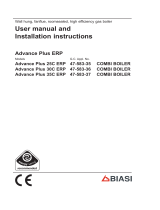 Biasi Advance Plus Combi ERP 25C, 30C and 35C User manual
Biasi Advance Plus Combi ERP 25C, 30C and 35C User manual
-
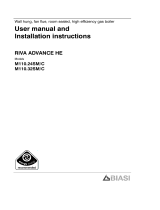 Biasi Riva Advance M110.24SM/C, M110.32SM/C User manual
Biasi Riva Advance M110.24SM/C, M110.32SM/C User manual
-
 Biasi Riva Compact M96.24SM/C2, M96.28SM/C2, M96.32SM/C2 User manual
Biasi Riva Compact M96.24SM/C2, M96.28SM/C2, M96.32SM/C2 User manual
-
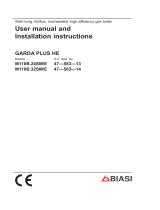 Biasi Garda Plus M110B.24SM/E, M110B.32SM/E User manual
Biasi Garda Plus M110B.24SM/E, M110B.32SM/E User manual
-
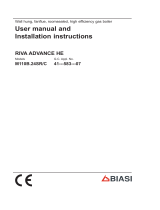 Biasi RIVA ADVANCE HE M110B.24SR/C User manual
Biasi RIVA ADVANCE HE M110B.24SR/C User manual
-
 Biasi Advance 25C User manual
Biasi Advance 25C User manual
Other documents
-
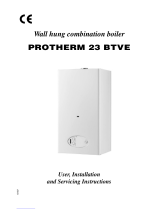 Protherm 23 BTVE User, Installation And Servicing Instructions
Protherm 23 BTVE User, Installation And Servicing Instructions
-
Sime SUPER 80 Installation guide
-
Sime Planet Super 4 F.S. Installation & Servicing Instructions Manual
-
Sime Planet Super 4 F.S. User manual
-
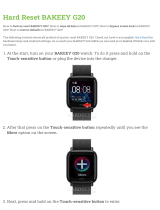 Bakeey G20 User manual
Bakeey G20 User manual
-
Sime Planet Super 4 W.M. Owner's manual
-
Sime Format B User guide
-
Sime Super 4 F.S MkI Owner's manual
-
Sime Murelle ELITE HE ErP Owner's manual
-
Savio GAIA 424 S User manual














































































